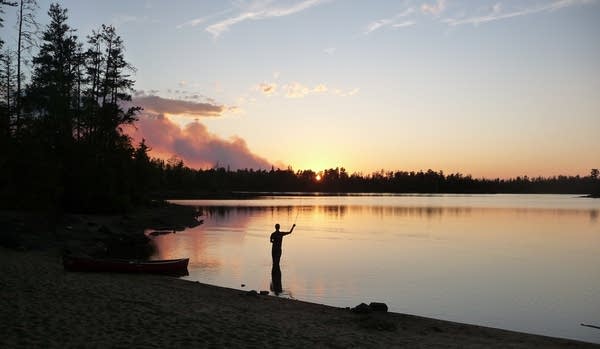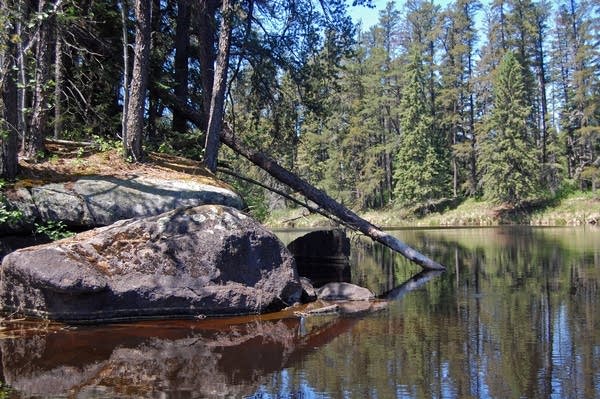Sell or swap? DNR considers Boundary Waters land exchange

Officials with the Minnesota Department of Natural Resources will unveil a plan Friday in hopes of fixing a long-standing problem involving state land inside the Boundary Waters Canoe Area.
The land is part of millions of acres that are supposed to generate revenue to support public schools in Minnesota. But Boundary Waters restrictions on motorized activities effectively prevent mining or logging on the land that could produce income.
When Congress carved the Boundary Waters out of the Arrowhead Region in the 1970s, it created an 86,000-acre dilemma for Minnesota.
The wilderness includes 2.5 million acres of valuable land from which the state derives revenue from timber sales, mining royalties and other sources of income.
Create a More Connected Minnesota
MPR News is your trusted resource for the news you need. With your support, MPR News brings accessible, courageous journalism and authentic conversation to everyone - free of paywalls and barriers. Your gift makes a difference.
Over more than a century, the investment has grown to more than $600 million and generates about $15 million a year. In 2009, the last year for which figures are available, $27 million was distributed to public schools from trust fund interest and dividends.
But more than 30 years later, Minnesota is not deriving revenue from the 86,000 acres because of restrictions on activities within the Boundary Waters area.

"The state has a fiduciary responsibility under the Constitution to manage school trust lands for financial return to the education system," said former Department of Natural Resources deputy commissioner Ron Nargang, who came up with the new plan. "Frankly, with those lands tied up inside the wilderness area, there's no opportunity to manage them for any kind of financial return, and we ought to fix that."
Officials hope to address the issue, but there are differences of opinion on what to do with the land.
The basic disagreement is whether to sell or swap. Should the state sell its land to the federal government for a lump sum of cash? Or, should the state swap its land for federal land outside the Boundary Waters that isn't bound by wilderness rules?
Iron Range lawmakers like state Rep. Tom Rukavina, DFL-Virginia, prefer the swap option. Rukavina argues that land — potentially with mineral and timber resources — is a more valuable asset over the long term.
"The overwhelming majority of the $600 million in our permanent school trust fund right now came from land we still own and the wealth off of that land, and not by selling it," he said.

That's why Iron Range lawmakers scuttled a deal in the mid-1990s to sell off the state's land in the Boundary Waters.
But the land swap Rukavina prefers runs into opposition from environmentalists. Some of the state's Boundary Waters property is on prime lakeshore land that's highly valuable, even with the wilderness restrictions. Committee chair Nargang said a swap would require the feds to give up far more of the lower-value land in the Superior National Forest than they'd get in the Boundary Waters.
"You start looking at Superior having to surrender three, four, maybe five times the acreage," Nargang said.
Nargang said environmentalists would never accept that much acreage being potentially freed up for mining or logging.
The proposed solution is, basically, to sell half and swap half. The state would sell 45,000 acres for as much as $100 million. And it would trade the other 41,000 acres for federal land of equal value.
"What I think is great about that is it reflects the consensus," Nargang said.
Superior National Forest superintendent Jim Sanders said he intentionally avoided offering federal land that contains copper and precious metals, which could attract mining companies.

"This is about a land exchange — it's less about mining," he said.
Sanders doesn't want the plan derailed by concerns that the swap could lead to environmentally hazardous mining.
"With that objective in mind, how do we find acres or land outside that meets our long-term management, isn't overly controversial in the public's mind, so that the two are not hooked totally together," he said.
But the DNR wants the deal to facilitate mining. One primary criterion the agency established was to try to acquire parcels where the federal government owns the surface land, but the state or private interests own rights to the minerals underneath.
Northeast Region Director Craig Engwall said mining would raise revenue for the school trust fund.
"It's a good goal; it's part of what we were trying to do," said Engwall.
But the prospect of additional Superior National Forest land being open to mining has several environmental groups opposed to a swap of any kind.
"Those lands were supposed to be permanently protected. That's why they were purchased by the federal government," said Kristin Larsen of Friends of the Cloquet Valley State Forest.
The haggling to this point has unfolded largely behind the scenes. The process should have been more transparent, said Paula Macabee, an attorney for the environmental group WaterLegacy.
"I've looked all over the Internet. I've looked at the Forest Service site. I've looked at the DNR," Macabee said. "There is a lack of information available to the public, and that doesn't seem an appropriate process."
DNR officials present their plan to an agency advisory committee on Friday. But the process will likely take years. Any deal has to go through a federal environmental review and real estate analysis, and secure millions of dollars in federal funding. It could be nearly a decade before any land actually trades hands.


